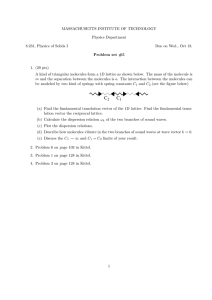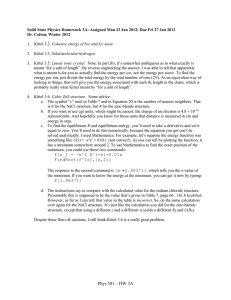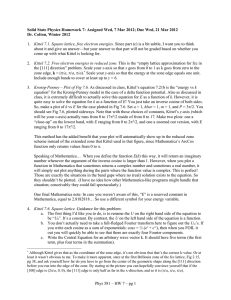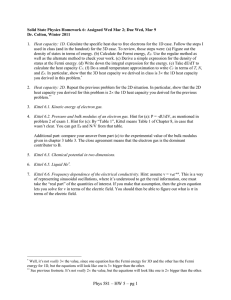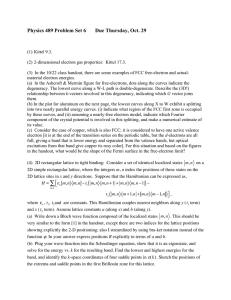hw 7
advertisement
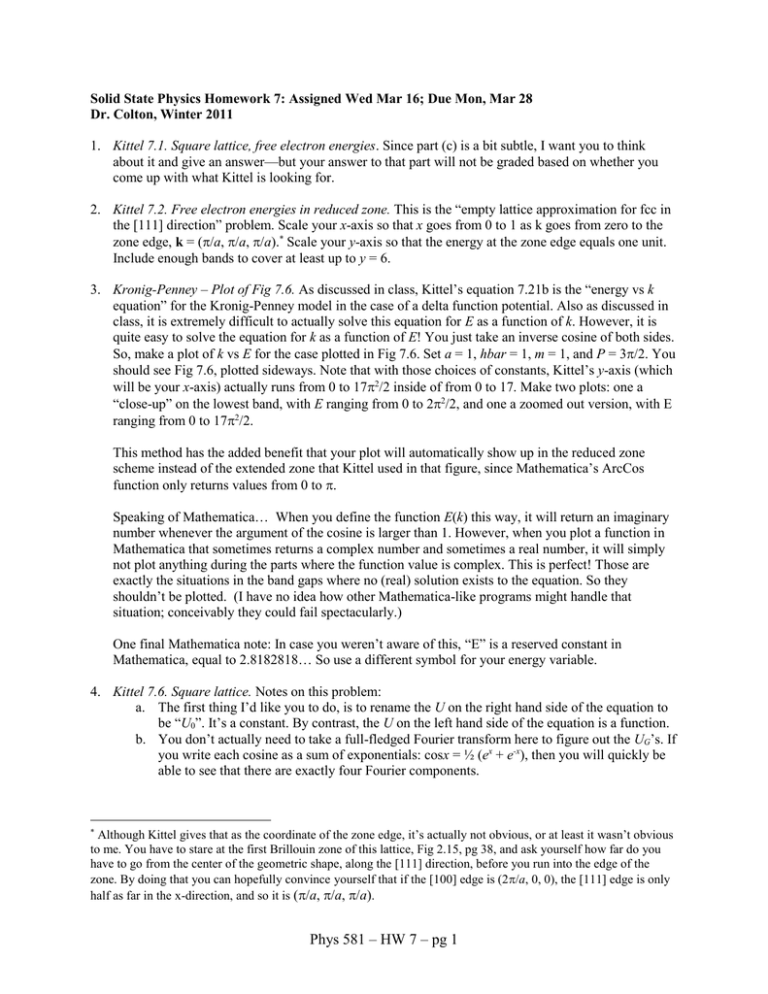
Solid State Physics Homework 7: Assigned Wed Mar 16; Due Mon, Mar 28 Dr. Colton, Winter 2011 1. Kittel 7.1. Square lattice, free electron energies. Since part (c) is a bit subtle, I want you to think about it and give an answer—but your answer to that part will not be graded based on whether you come up with what Kittel is looking for. 2. Kittel 7.2. Free electron energies in reduced zone. This is the “empty lattice approximation for fcc in the [111] direction” problem. Scale your x-axis so that x goes from 0 to 1 as k goes from zero to the zone edge, k = (/a, /a, /a).* Scale your y-axis so that the energy at the zone edge equals one unit. Include enough bands to cover at least up to y = 6. 3. Kronig-Penney – Plot of Fig 7.6. As discussed in class, Kittel’s equation 7.21b is the “energy vs k equation” for the Kronig-Penney model in the case of a delta function potential. Also as discussed in class, it is extremely difficult to actually solve this equation for E as a function of k. However, it is quite easy to solve the equation for k as a function of E! You just take an inverse cosine of both sides. So, make a plot of k vs E for the case plotted in Fig 7.6. Set a = 1, hbar = 1, m = 1, and P = 3/2. You should see Fig 7.6, plotted sideways. Note that with those choices of constants, Kittel’s y-axis (which will be your x-axis) actually runs from 0 to 172/2 inside of from 0 to 17. Make two plots: one a “close-up” on the lowest band, with E ranging from 0 to 22/2, and one a zoomed out version, with E ranging from 0 to 172/2. This method has the added benefit that your plot will automatically show up in the reduced zone scheme instead of the extended zone that Kittel used in that figure, since Mathematica’s ArcCos function only returns values from 0 to . Speaking of Mathematica… When you define the function E(k) this way, it will return an imaginary number whenever the argument of the cosine is larger than 1. However, when you plot a function in Mathematica that sometimes returns a complex number and sometimes a real number, it will simply not plot anything during the parts where the function value is complex. This is perfect! Those are exactly the situations in the band gaps where no (real) solution exists to the equation. So they shouldn’t be plotted. (I have no idea how other Mathematica-like programs might handle that situation; conceivably they could fail spectacularly.) One final Mathematica note: In case you weren’t aware of this, “E” is a reserved constant in Mathematica, equal to 2.8182818… So use a different symbol for your energy variable. 4. Kittel 7.6. Square lattice. Notes on this problem: a. The first thing I’d like you to do, is to rename the U on the right hand side of the equation to be “U0”. It’s a constant. By contrast, the U on the left hand side of the equation is a function. b. You don’t actually need to take a full-fledged Fourier transform here to figure out the UG’s. If you write each cosine as a sum of exponentials: cosx = ½ (ex + e-x), then you will quickly be able to see that there are exactly four Fourier components. Although Kittel gives that as the coordinate of the zone edge, it’s actually not obvious, or at least it wasn’t obvious to me. You have to stare at the first Brillouin zone of this lattice, Fig 2.15, pg 38, and ask yourself how far do you have to go from the center of the geometric shape, along the [111] direction, before you run into the edge of the zone. By doing that you can hopefully convince yourself that if the [100] edge is (2/a, 0, 0), the [111] edge is only half as far in the x-direction, and so it is (/a, /a, /a). * Phys 581 – HW 7 – pg 1 c. Your Central Equation then has five terms (the first term, plus four terms in the summation). However, as discussed in class, in principle when you want to solve the Central Equation for a particular k, you have to also write down equations for all of the other k’s that are connected to that k by a reciprocal lattice vector. That’s an infinite number of equations, which you then can write as a matrix, and solve by setting the determinant equal to zero. However, to actually solve the problem, you need to make a decision of where to cut off the matrix because even Mathematica has trouble with infinite matrices. d. Since Kittel says you’re looking for a 22 matrix equation, you can make the approximation that only two k values are important: k = (/a, /a) (that’s the one you are looking for), and k = (–/a, –/a) (in some sense, the “closest” k to the one you’re looking for). So disregard all of the C coefficients for the other k’s. 5. Perturbation theory and sodium. (From Stokes problem 8-16.) Consider sodium metal. Let each atom be at a lattice point R. Consider a periodic potential U which is equal to U0 in a small cube of side 2b centered on each atom and is zero everywhere else. (a) Find an expression for the energy of an electron state at the boundary of the first Brillouin zone along the [110] direction. (Hint: Find a (0) vector k such that k = k – G for some reciprocal lattice vector G and such that Ek(0) Ek .) If b = a/4 and the gap at this zone boundary is equal to 0.5 eV, find the value of U0. (b) Using the value obtained for U0, find the second-order correction to the energy of an electron state at the Fermi surface in the [110] direction.* (Hint: Use Eqn 4 from the Perturbation Theory handout, summing over the states k = k – G in the 12 nearest-neighbor unit cells of the reciprocal lattice.) Note from Dr. Colton: In this problem we make an approximation where we take only 12 terms of a summation. That’s related, but not identical, to the approximation used in the last problem where we truncated a matrix in order to solve it. * That is, with k = kFermi/sqrt(2) (1,1,0). Phys 581 – HW 7 – pg 2
